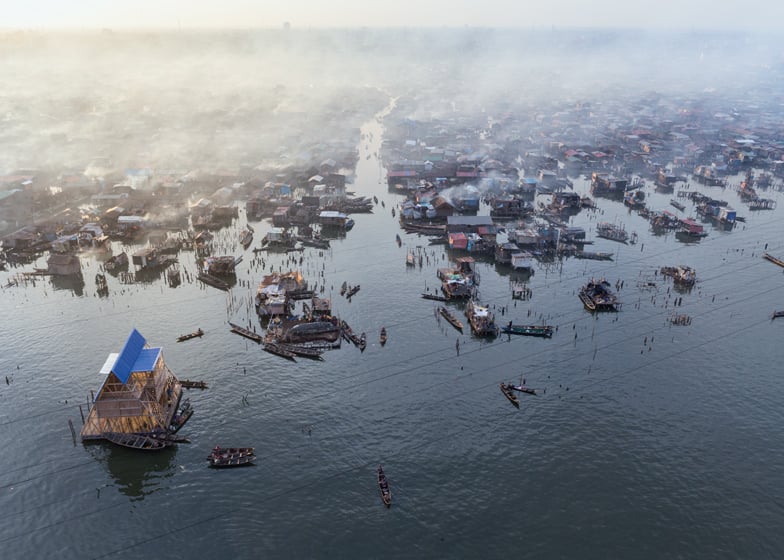A row has broken out over architect Kunlé Adeyemi's award-winning Makoko Floating School following its collapse earlier this week, with a community leader in Lagos claiming pupils were evacuated three months ago over safety concerns and architecture critics questioning its credentials.
Noah Shemede, headmaster of a nearby school whose pupils made use of the water-borne facilities, told Dezeen that the three-storey, prism-shaped wooden structure was "not strong".
"I moved the kids from the school because I believed it would cause danger to the kids," Shemede told Dezeen via Facebook. "I moved for the safety of the kids."
Shemede's claims contradict comments made by Nigerian architect Adeyemi, who said the school was decommissioned after three years' successful service to make way for an improved version.
NLÉ, Adeyemi's studio, issued a statement earlier this week titled "Makoko Floating School comes down for upgrade" which claimed the prototype school "had been out of use in anticipation of reconstruction."
"After three years of intensive use and exceptional service to the community, the first prototype structure Makoko Floating School has come down on June 7, 2016," it said, adding that it was working on a new version.
The statement, issued in response to reports that a storm had destroyed the structure, confirmed that the school had suffered an "abrupt collapse."
However Shemede said the school had only been in use for a few months.
"I started using the school last year, in October 2015, and I moved the kids from the school in March this year because of the safety," said Shemede, who is head of the nearby Wanyninna Primary School in Makoko, an informal neighbourhood built on stilts over the Lagos Lagoon.
"The [floating] school is not strong," he added.
Adeyemi responded by saying that media reports of Shemede's views were "unfortunate".
"It's unfortunate that at this stage they take the view point of an individual to represent that of a community on a structure that belongs to the community," he told Dezeen.
Built of timber struts and floating on a platform made of 250 plastic barrels, Makoko Floating School became a symbol of hope for the deprived area, which is home to 100,000 inhabitants but which has few facilities and has been described as "the world's biggest floating slum".
The international attention it garnered helped protect the community it served from eviction by the Nigerian government, which in 2012 declared the stilt district illegal.
The school also promised to provide much-needed educational facilities, as well as elevating the reputation of its architect.
But Shemede downplayed the importance of the much-lauded project, which has won several architectural awards. "The school can only accommodate less than 60 kids," he said.
The destruction of the school and the ensuing row has led to a rapid re-evaluation of its credentials, with some suggesting its role in helping the community had been exaggerated.
An article in The Guardian this week described the collapse as "a serious blow to the future of the remarkable floating city," and reported frustrations in the community over its delayed opening and its small capacity, despite being taller than the typical single-storey structures in the slum.
Writing in AR magazine, architecture professor Tomà Berlanda described Adeyemi's statement as "worryingly misleading".
"The fact is that the prototype’s load-bearing structure fell apart, and with it the hopes of the community," wrote Berlanda, a professor at the University of Cape Town's architecture school.
Berlanda said that the photogenic project had captured the imagination of architects around the world but added: "At this stage, you are left wondering how much of the use of the building as a school was staged."
Phineas Harper, deputy director of the Architecture Foundation in London, wrote on his Facebook page that the architecture media "fell into a PR trap" over the school.
Harper said the building's collapse brought "critical lessons for architectural journalists."
"We fell into a PR trap, which hinged on sexy Iwan Baan photographs and respected publications not having the budgets to properly investigate their features thoroughly," he wrote.
Asked to respond to the criticisms, Adeyemi told Dezeen: "We are meeting with the community leaders [on Saturday] and we will be in a position to give a much more comprehensive and consolidated report next week to avoid he said/she said scenarios. I therefore have no comments at this point."
Meanwhile a crowdfunding campaign has been launched to build extra facilities at Shemede's Whanyinna Primary School in Makoko to replace those lost in the storm.
"It will be a tragedy if we can't turn this setback for the community into something meaningful and use the publicity to build something more sustainable," says the text accompanying the campaign.
"So, instead of doing an architectural project that puts the community interests in second place, we're proposing to do something simpler that is being requested by the community."
Adeyemi, 40, is currently exhibiting his improved prototype of the school, called MFS II, at the Venice Architecture Biennale. Last month he was awarded the Biennale's prestigious Silver Lion for the project, which is "more robustly engineered" and "adapted for easy prefabrication".

